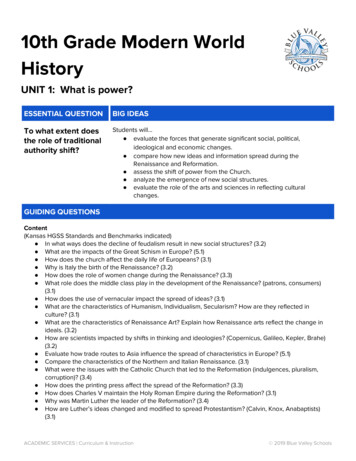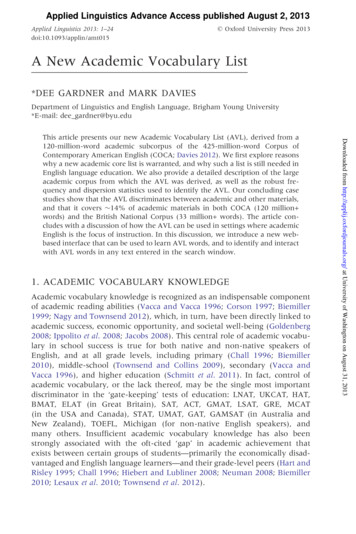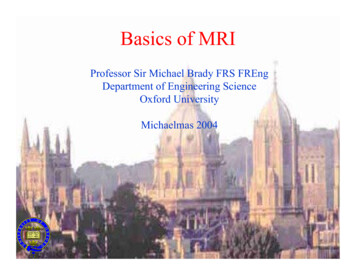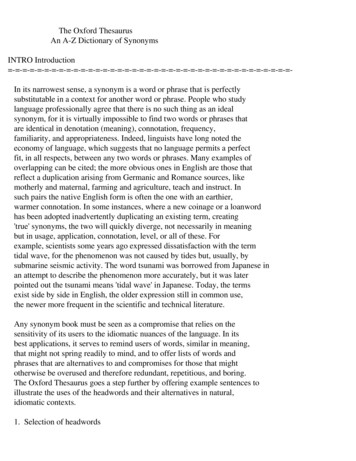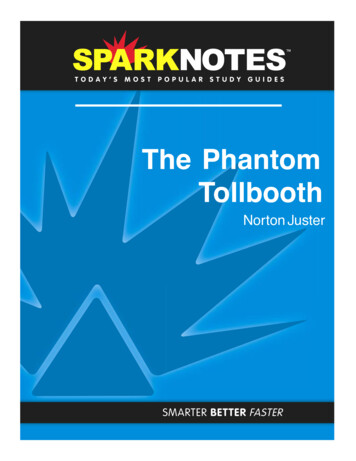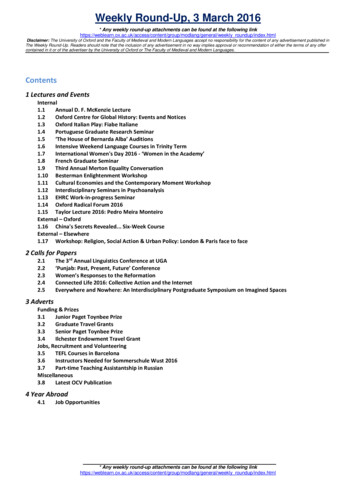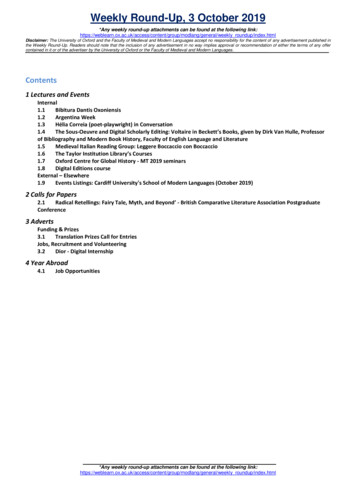
Transcription
THE OXFORDHISTORY OFMODERN WARCHARLES TOWNSHENDEditorOXFORD UNIVERSITY PRESS
THE OXFORDHISTORY OFMODERN WAR
the editorCHARLES TOWNSHENDis Professor of International History, Keele University.
THE OXFORDHISTORY OFMODERNWA Redited byCHARLES TOWNSHEND1
3Great Clarendon Street, Oxford ox2 6dpOxford University Press is a department of the University of Oxford.It furthers the University’s objective of excellence in research, scholarship,and education by publishing worldwide inOxford New YorkAthens Auckland Bangkok Bogotá Buenos Aires CalcuttaCape Town Chennai Dar es Salaam Delhi Florence Hong Kong IstanbulKarachi Kuala Lumpur Madrid Melbourne Mexico City MumbaiNairobi Paris São Paulo Singapore Taipei Tokyo Toronto Warsawwith associated companies in Berlin IbadanOxford is a registered trade mark of Oxford University Pressin the UK and in certain other countriesPublished in the United Statesby Oxford University Press Inc., New York Oxford University Press 2000The moral rights of the author have been assertedDatabase right Oxford University Press (makers)The text of this volume first published 1997 in The Oxford Illustrated History of Modern WarFirst issued as The Oxford History of Modern War 2000All rights reserved. No part of this publication may be reproduced,stored in a retrieval system, or transmitted, in any form or by any means,without the prior permission in writing of Oxford University Press,or as expressly permitted by law, or under terms agreed with the appropriatereprographics rights organization. Enquiries concerning reproductionoutside the scope of the above should be sent to the Rights Department,Oxford University Press, at the address aboveYou must not circulate this book in any other binding or coverand you must impose this same condition on any acquirorBritish Library Cataloguing in Publication DataData availableLibrary of Congress Cataloging in Publication DataData availableISBN 0–19–285373–21 3 5 7 9 10 8 6 4 2Typeset byCambrian Typesetters, Frimley, SurreyPrinted in Great Britain byCox & Wyman Ltd.Reading, Berkshire
PREFACEThe aim of this book is to provide a history not merely of modernwarfare but of modern war as a whole. It is an attempt to gobeyond military history. Violent conflict is as old as humanity, butmodern war is different. Somewhere between the sixteenth andeighteenth centuries an historic change took place in the militarypower of European states. The first result was to end for ever thevulnerability of Europe to invasion and conquest from Asia. Thesymbolic turning-point was the defeat of the Ottoman besiegers ofVienna in 1683. Thereafter the military balance shifted furtheruntil, in the nineteenth century, the West came to dominate theworld. This shift cannot be understood in purely military terms. Itwas part of a complex process of social and economic modernization.War is more than military operations. Modern war, above all,came to enlist every aspect of life. This enlargement has altered theway historians write about war. Traditional military history hasevolved into a broader and deeper approach to the relationship between war and society. The contributors to this book have aimed todraw together recent interpretative studies to provide as clear a viewas possible of this complex relationship. The book is divided intotwo parts, the first offering an account of the historical developmentof war since the time of the Renaissance in Europe, the second providing overviews of a number of vital dimensions which have combined to create the characteristic modern structure of war. The finalchapter addresses the question whether this distinctively modernform of war will survive into the twenty-first century.
CONTENTSl i s t o f p l at e slist of contributorsixxiPart I: The Evolution of Modern War1. Introduction: The Shape of Modern Warc h a r l e s tow n s h e n d32. The Military Revolution I: The Transition toModern Warfarejohn childs203. The Military Revolution II: EighteenthCentury Warjeremy black404. The Nation in Arms I: The French Warsalan forrest555. The Nation in Arms II: The Nineteenth Century 74david french6. Imperial Wars: From the Seven Years Warto the First World Wardouglas porch947. Total War I: The Great Warjohn bourne1178. Total War II: The Second World Warrichard overy138
viiiContents9. Cold Warp h i l i p tow l e10. People’s Warc h a r l e s tow n s h e n d158177Part II: Elements of Modern War11. Technology and War I: to 1945m a rt i n va n c r e v e l d12. Battle: The Experience of ModernCombatrichard holmes20122413. Sea Warfarejohn b. hattendorf24514. Air Warfarerichard overy26215. War and the People: The Social Impact ofTotal Warmark roseman28016. Women and Warjean bethke elshtain30317. Against Waradam roberts31718. Technology and War II: Postmodern War?m a rt i n va n c r e v e l d341further readingchronologyindex361373381
LIST OF PLATES1. Napoleon at the Battle of Wagram, Vernet ND-Viollet2. Penetrating power of gunsK. Macksey, Technology in War, 1986, Grub Street,Syndics of Cambridge University Library3. The Great Siege of Namur, 1695The Royal Collection Her Majesty QueenElizabeth II4. Casualties of the American Civil WarNational Archives W&C # 253 165-SB365. French mounted infantry in Morocco, 19126. War 1918 styleIWM Q107117. Soviet infantry operating with T-34 tank8. A Balloon Site, Coventry, Dame Laura KnightImperial War Museum, London9. Boer fighters caught crossing a railwayBritish Library10. The machine-gunNational Archives 127-N-A18783711. Troops, Saipan landing, 1944Bara-King/National Archives 127 GW1303 8326112. Still from 1930s film Things to ComeLondon Films/United Artists (courtesy Kobal)
xList of Plates13. Soviet pilot Alexander PokryshkinPictorial Press14. Civilians leaving burning city of Königsberg, 1945Bildarchiv Preussischer Kulturbesitz15. American women campaigning, 1922FPG International/Robert Harding Picture Library16. Atomic explosion over Bikini, 1946Bara-King/National Archives 80G402822
LIST OF CONTRIBUTORSJeremy Black is Professor of History at the University of Exeter. His 33books include Why Wars Happen (1998); War and the World 1450–2000(1998); Warfare in the Eighteenth Century (1999); and Britain as a MilitaryPower 1688–1815 (1999). War—Past, Present and Future will appear laterthis year.John Bourne is Senior Lecturer in Modern History at the University ofBirmingham. He is the author of Patronage and Society in NineteenthCentury England (1986); Britain and the Great War 1914–1918 (1989).John Childs is Professor of Military History at the University of Leeds. Heis the author of The Army of Charles II (1976); The Army, James II, andthe Glorious Revolution (1980); Armies and Warfare in Europe1648–1789 (1982); The British Army of William III, 1689–1702 (1987);The Nine Years War and the British Army 1688–1697: The Operations inthe Low Countries (1991).Jean Bethke Elshtain is Rockefeller Professor of Social and Political Ethicsat the University of Chicago. She is the author of Public Man, PrivateWoman (1981); Women and War (1987); Just War Theory (1992).Alan Forrest is Professor of Modern History at the University of York. Heis the author of The French Revolution and the Poor (1981); Conscriptsand Deserters: The Army and French Society during the Revolution andEmpire (1989); Soldiers of the French Revolution (1990); The Revolutionin Provincial France (1996); and editor of Reshaping France: Town,Country and Region during the French Revolution (1991).David French is Professor of History at University College London. He isthe author of British Economic and Strategic Planning, 1905–1915 (1982);British Strategy and War Aims, 1914– 1916 (1986); The British Way inWarfare 1688–2000 (1990).John B. Hattendorf is Ernest J. King Professor of Maritime History at theNaval War College, Rhode Island. He is the author of England in the Warof the Spanish Succession: A Study of the English View and Conduct ofGrand Strategy, 1702–1712 (1987); and editor of Maritime Strategy and
xiiList of Contributorsthe Nuclear Age (1982); Maritime Strategy and the Balance of Power(1989); The Limitations of Military Power (1990).Richard Holmes is Professor of Military and Security Studies at CranfieldUniversity and Brigadier TA at Headquarters Land Command. He is authorof The Little Field-Marshal: Sir John French (1981), The Road to Sedan:The French Army, 1866–70 (1984); Firing Line (1985); [with John Keegan]Soldiers: A History of Men in Battle (1985); Riding the Retreat (1995); TheFirst World War (1999). In 1996 he presented War Walks on BBC TV. Heis currently editing The Oxford Companion to Military History.Richard Overy is Professor of History at King’s College, London. He is theauthor of The Nazi Economic Recovery 1932–38 (1982); Goering: TheIron Man (1984); The Air War 1939–1945 (1980); The Road to War(1989); Why the Allies Won (1996).Douglas Porch is Professor of National Security Affairs at the US NavalPostgraduate School in Monterey, California. He is the author of Army andRevolution: France 1815–1848 (1974); The March to the Marne: TheFrench Army, 1871–1914 (1981); The Conquest of Morocco (1983); TheConquest of the Sahara (1984); The French Foreign Legion (1991).Adam Roberts is Montague Burton Professor of International Relations,Oxford University; author of Nations in Arms: The Theory and Practice ofTerritorial Defence (2nd edn., 1986); editor of The Strategy of CivilianDefence (1967); Documents on the Laws of War (3rd edn., 2000); HugoGrotius and International Relations (1990); and United Nations, DividedWorld (2nd edn., 1993).Mark Roseman is Senior Lecturer in History at Keele University. He is theauthor of Recasting the Ruhr (1994); and editor of Generations in Conflict:Youth Revolt and Generation Formation in Germany 1770–1968 (1995).Philip Towle is the Director of the Centre of International Studies inCambridge. He is the author of Arms Control and East–West Relations(1983); Pilots and Rebels: The Use of Aircraft in Unconventional Warfare1918–1988 (1989); and editor of Estimating Foreign Military Power(1982).Charles Townshend is Professor of International History at KeeleUniversity. He is the author of The British Campaign in Ireland 1919–1921(1975); Political Violence in Ireland (1983); Britain’s Civil Wars:Counterinsurgency in the Twentieth Century (1986); Making the Peace:
List of ContributorsxiiiPublic Order and Public Security in Modern Britain (1993); and Ireland:the 20th Century (1999).Martin van Creveld is Professor of History at the Hebrew University ofJerusalem. He is the author of Hitler’s Strategy 1940–1941: The BalkanClue (1973); Supplying War: Logistics from Wallenstein to Patton (1977);Fighting Power (1982); Command in War (1985); Technology and War(1989); The Transformation of War (1991).
Part IThe Evolution ofModern War
1IntroductionThe Shape of Modern WarCHARLES TOWNSHEND‘The musket made the infantryman and the infantryman madethe democrat.’ It would be hard to find a pithier expression thanthis, in General J. F. C. Fuller’s book The Conduct of War, of theidea that modern war and modern society are symbioticallylinked. The triumph of uniform, economical foot-soldiers overindividual, extravagant horsemen—in a word, the triumph ofthe ordinary people over the aristocracy—represented the decisive juncture of modernization. ‘Boney’ Fuller, like many military officers of his generation, was hardly an admirer ofmodernity as a whole, and especially not of democracy. In thesame way, the mass armies that accompanied it were an objectof suspicion if not of contempt for those who hankered after thetraditional virtues of military élites. Yet their sense of the profound change that had come about was accurate enough.Modern war is the product of three distinct kinds of change—administrative, technical, and ideological. Not all of these can beseen in any straightforward way as ‘progress’, though they seemto be irreversible. Nor have they developed at the same pace.Military technology has produced the most striking and indeedterrifying symbols of modern war: the machine-gun, the rocket,the atomic bomb. The increase in power and sophistication ofweapon systems has been exponential. Between the first generaladoption of efficient firearms in the seventeenth century and theproduction of breech-loading guns and smokeless propellants in
4Introductionthe middle of the nineteenth, the pace of change was slow. Improvements in technique (professionalism, training, and tactics),rather than in technology, brought the most substantial results.Later the balance altered.Technological change may appear to be an independent process,governed only by the extent of scientific knowledge and the limits ofscience and manufacturing. But military institutions have tended tobe more conservative than other social groups. Soldiers haveseldom been in the forefront of technological development, andmore often reluctant to welcome new weapons. Tradition hasalways been important in fostering the esprit de corps of fightingunits, and can lead to fossilization. So can the tendency—actuallyincreased by professionalization, which removed young princes andnobles from high command—for senior officers to be substantiallyolder than their juniors. There are many striking examples of failure to embrace new technology, none perhaps more disastrous thanthat of the imperial Chinese navy, which could have had the world’smost advanced naval artillery in the early sixteenth century, but rejected it in favour of traditional ramming and boarding tactics.The reason for this lay not simply in mental conservatism, butin the functions the Chinese navy had to perform. Its actual opponents were not battle fleets similar to itself, but Japanese piratebands. Plainly, technology is the creature as well as the creator ofsocial and political conditions. In Europe, during the slow phaseof weapon development, other profound changes were happening. The process often labelled ‘the rise of the modern state’ wasa cocktail of administrative, economic, and social changes. Someof these, such as the growth of standing armies and of militaryprofessionalism, were not without precedent, as John Childspoints out. Their novelty in the sixteenth century was in contrastto the protean military institutions of the Middle Ages, whichhad taken their flexible shapes from the irregular pattern of military obligations amongst sovereigns and subjects. In Englandthe shift from the unpredictable results of the negotiations between Charles I and his parliaments to the regular structure ofthe New Model Army exemplifies the change; after that evenEngland, which was permitted the luxury of an anti-military attitude, never lacked a standing army.
Introduction5In Europe, moreover, several states were emerging simultaneously as rival powers. Their competition provided a powerfulimpetus to military innovation, and their frequent wars testedand honed these experiments. The result was the ‘military revolution’: though this concept did not appear until the 1950s,when Michael Roberts carried out his pioneering research on theSweden of Gustavus Adolphus. Roberts argued that a set of interlinked developments between the mid-sixteenth and the midseventeenth centuries had transformed the nature of war, andalso of the states which waged it. The overthrow of feudal cavalry by infantry led to the dramatic enlargement of armies, anda consequent growth in the administrative and financial structures needed to maintain them. In the process, the apparatus ofthe state became for the first time distinctively modern: personalfealty was replaced by public service.In the forty years since it was proposed, the military revolution hypothesis has been first extended and then challenged,mainly on the grounds that the pace of change was not fastenough to make the concept of ‘revolution’ meaningful. Certainly some central strands of the process, such as the growth inthe size of armies, may not have followed the pattern suggestedby the original hypothesis. It is probably impossible to identify apoint at which a critical mass of the elements of modern war hadbeen brought together: was it when the matchlock was replacedby the flintlock musket, or perhaps when the socket bayonet (replacing the primitive plug variety) at last integrated firearmswith the ancient steel arme blanche? None the less, in the longerview, the scale of change was decisive. By the late eighteenth century the ‘sinews of power’, as one historian has described thefiscal-military institutions of Britain, had been permanentlytransformed.The final transformation of war, as General Fuller argued, wassealed by the French Revolution. The transformation was atleast as much a perceptual as an operational shift. Jeremy Blackholds that the contrast between eighteenth-century and revolutionary warfare has often been exaggerated. Karl von Clausewitz, above all, whose writings provided the most striking andinfluential interpretation of the Napoleonic epoch, always
6Introductionharped on that contrast. For him its essence was not technical,or even organizational, but psychological. The Revolutionchanged the minds of men and women. After the Legislative Assembly decree la patrie en danger (1792) there were no limits totheir commitment to defend it. The decree of the levée en massein August 1793 projected an image of mass mobilization thathas never lost its force:From this moment until the enemy is driven from the territory of theRepublic, all the French people are permanently requisitioned for thearmies. The young men will go to the front, married men will forgearms and carry supplies, women will make tents and clothing, childrenwill divide old linen into bandages, old men will be carried into thesquares to rouse the courage of the soldiers, to teach hatred of kingsand the unity of the republic.Revolutionary rhetoric was seldom matched by reality, but, asPeter Paret has argued, the fact that this rhetoric was used, something unthinkable a decade earlier, marked a change withtremendous practical significance. Revolutionary soldiers had awholly new kind of self-respect, and were treated accordingly.The conduct of war became more urgent and ambitious. LazareCarnot, the organizer of the new republican armies, called forunlimited war, guerre à outrance, prosecuted ‘to the bitter end’,the extermination of the Revolution’s enemies. In the words ofSaint-Just, Robespierre’s colleague on the Committee of PublicSafety, ‘The republic consists in the extermination of everythingthat opposes it.’To Clausewitz, the artificiality of eighteenth-century stateshad been the root cause of their caution in war. Battle had notalways been avoided, but had often not been sought; superiorstrategy might do without it. Occupation of provinces, and capture of fortresses, were the real objects of operations. In place ofthis the Revolution, releasing the volcanic natural force of patriotic citizenship, restored the clash of armies to its logical placeat the centre of strategy. In the eighteenth century, no battle hadled to the destruction of a defeated army. The rapid pursuit required would have been too risky to the victorious side: logistical confusion and wholesale desertion would certainly have
Introduction7wrecked it. The French revolutionary armies sought battle witha new energy and persistence. The battles themselves did notchange dramatically in scale or nature, at least until Wagram in1809. (There Napoleon brought some 160,000 troops into action, as compared with a scant 16,000 at Rivoli or Marengo,and around 70,000 at Austerlitz.) What changed was their frequency.The mass mobilization launched by the decree of the levée enmasse in 1793 did not itself alter the nature of military organization or methods. In so far as the revolutionary armies employed new tactics—such as the large-scale use of skirmishersand sharpshooters (tirailleurs), and the substitution of columnfor line formations—these had been prefigured by older commanders and theorists. Nor was there a revolutionary change inthe logistics of military operations. Although the French armieswere able to ‘live off the country’ in a more flexible way thantheir predecessors, because their easier discipline permittedtroops to forage more freely, and although they were in a sensedriven to do so by the parlous state of public finances, there werestill fairly strict limits to this flexibility. Above all, the supply ofmunitions imposed firm restrictions on movement. But the surgeof recruitment transformed the capacity of armies to continueadvancing even after sustaining serious losses: this put tremendous pressure on their opponents. And ultimately the increase instrength made it possible to ignore fortresses and abandon theold obsession with siege warfare. Napoleon noted that an armyof 250,000 could easily detach a fifth of its strength and still beable to overrun an entire country. At a stroke the logistical straitjacket of the past was thrown off.Here was the explanation of what appears at first sight, asMartin van Creveld has said, incomprehensible: with technological means no more advanced than those of his predecessors—indeed he was quite conservative in this sphere—‘Napoleon wasable to propel enormous forces right across Europe, establish anempire stretching from Hamburg to Sicily, and irreparably shatter an entire world.’ The impact of this extraordinary adventurecan hardly be overstated. It was the dynamism of Napoleonicstrategy coupled with the scale of his objectives—the overthrow
8Introductionnot just of armies but of entire states—which revealed to Clausewitz the elemental truth of what he called ‘absolute war’, warwithout restraints or limits, following the logic of force alone. ‘Ifone side uses force without compunction’, he wrote at the beginning of his great work On War, ‘while the other side refrains,the first will gain the upper hand. It will force the other to follow suit; they will drive each other towards extremes.’It is not uncommon for people, especially in the Englishspeaking world, to wonder whether Clausewitz’s reputation hasnot been over-inflated, and whether his perceptions have anycontemporary relevance. The answer must be that, amongstwriters on war, Clausewitz is in a category of his own. It is notthat all his ideas are universally true—certainly not as far as tactics and strategy are concerned—but that his writing is uniquelysensitive to the human dimension of modern war. Indeed hisown theory rejected the pretensions of ‘scientific’ laws of war touniversal validity, and emphasized the power of genius to transform boundaries. His writing exudes a sense of what the leadingphilosopher of his time, Immanuel Kant, called ‘the crooked timber of humanity’.No sooner had Clausewitz sketched out his exhilarating butdisturbing vision of absolute war than he retreated a little fromit. His famous insistence that war can only be sensibly understood as an instrument of policy, ‘a continuation of political activity by other means’—the means were different but the endsmust make political sense—was a way of saying that not all warswould thenceforth necessarily display the extremism of theFrench revolutionary model. Limited political objectives wouldstill produce limited wars. In a different sense, too, the extremism of war was pinned back by what Clausewitz labelled ‘friction’. Everything in war looks simple, he noted disarmingly: ‘theknowledge required does not look remarkable, the strategic options are so obvious that by comparison the simplest problem ofhigher mathematics has an impressive scientific dignity.’ Yetwhile ‘everything in war is simple, the simplest thing is difficult.The difficulties accumulate, and end by producing a kind of friction that is inconceivable unless one has experienced war.’Underlying all such restrictions, though, the essence of modern
Introduction9war remained. ‘Once barriers—which in a sense consist only inman’s ignorance of the possible—are torn down, they are noteasily set up again.’ Every future war would tend to demonstratethe same basic characteristics: mass mobilization, ideologicalmotivation, ruthless prosecution. War would increasingly beseen as the acid test, not merely of military and economicstrength, but more fundamentally of the social cohesion ofstates, and the viability of nations. In the words of a member ofthe Frankfurt Parliament during the German revolutions of1848, ‘mere existence does not entitle a people [volk] to political independence: only the force to assert itself as a stateamongst others.’ The ideological foundation of states after theFrench Revolution was nationalism, and the wars of the nineteenth century were primarily national conflicts. In fact, thenineteenth century saw a remarkable reduction in the frequencyand duration of major (and even minor) wars. But the stakeswere high and the outcomes transformed the political structureof Europe.In the nineteenth century, too, there was a true technologicalrevolution in war. The advent of the breech-loading rifle fundamentally altered the traditional face of battle. Rifling itself dramatically lengthened the effective range of firearms, but earlymuzzle-loading rifles like the Minié actually required greaterskill to maximize their effect. The Prussian Dreyse rifle was lessaccurate, and the design of its breech and thin firing pin (whichgave it its famous sobriquet ‘needle gun’) were too vulnerable towear and tear. But the fact that the Dreyse could be fired by anovice at twice the rate of an expertly handled Minié—someseven rounds a minute—was decisive, as the war of 1866demonstrated. Within twenty years or so the development ofsuch bolt-action magazine rifles as the Mauser and the Lebel,using smaller-bore bullets propelled by smokeless powder,brought infantry weapons to a level of firepower which wouldremain fairly constant until after the Second World War. In thesame period the machine-gun was transformed from the unwieldy multiple-barrelled Gatling gun and the French mitrailleuse through Hiram Maxim’s manufacture, in themid-1880s, of a mechanism driven by the weapon’s own recoil.
10IntroductionThe final impact of all these changes did not become fullyclear in Europe itself in the nineteenth century. The most striking military successes, the victories of Prussia over Austria andFrance in the wars of German unification, were widely misread.Though nobody could miss the demonstration of the power ofnew weapons—as in the massacre of the Prussian 1st Guards Division’s advance against French troops armed with the Chassepot rifle at Saint-Privat on 18 August 1870—the overall resultseemed to confirm that decisive victories were still possible forarmies with sophisticated organization and command structures. Indeed, the Prussian Guards made what Michael Howardcalled ‘a small landmark in military history’ a few weeks later,by replacing their close-order tactics with a looser deployment intheir successful assault on Le Bourget. Helmuth von Moltke wasfar from being a commander in the Napoleonic mould, but bydeveloping the Prussian general staff into the vital nervous system of the army he transformed the potential of the short-serviceconscript force. Until then, even radical military commentatorslike Friedrich Engels continued to subscribe to the persistent belief that professional or long-service troops would remain superior. Modern weapons eliminated that traditional superiority,and modern staff work ensured that decisive numerical weightcould be efficiently deployed. For the first time it could be saidthat mobilization planning was an integral part of strategy.The sheer military effectiveness of Moltke’s armies, which wasexaggerated by the command weaknesses of their opponents,disguised the looming problems of mass warfare. Moltke himself, chastened by the frustrations of the ‘people’s war’ in Francein the winter of 1870–1, was perhaps less sanguine than his admirers and imitators. ‘The days of cabinet wars are past; now wehave only the people’s war’, he declared in 1887. ‘There is notone [great power] that can be so completely overcome in one oreven in two campaigns that it will be forced to conclude an onerous peace; not one that will be unable to rise again, after a year,to renew the struggle.’ He foresaw a new age of Seven YearsWars or even Thirty Years Wars. The Russo-Turkish War of1877–8 had indicated the shape of things to come: the combination of earthworks and modern weapons in the Turks’ defence
Introduction11of Plevna held up the Russian advance for five months. Thispower of resistance in a state which hardly ranked as one ofMoltke’s great powers showed what might be expected in fullscale war.Had Europeans been able to recognize it, a still more soberingvision of the future had been provided by the American Civil War.Moltke himself dismissed the American armies—nearly half amillion men on the Confederate side, over twice that numberraised by the Union—as mere mobs chasing each other about thecountryside. Certainly they were quite unlike European armies,more mercurial in temper and unreliable in discipline. But the difficulty of fulfilling Abraham Lincoln’s unambiguous demand to‘destroy the rebel army’ was not simply due to lack of military efficiency. Admittedly, Union generals before Ulysses S. Grant oftenlacked his confidence and energy. His epigrammatic assertionthat ‘the art of war is simple enough; find out where your enemyis, get at him as soon as you can, strike at him as hard as you can,and keep moving on’ was suitably Clausewitzian; but even hecould not easily overwhelm entrenchments of the kind dug by theConfederate defenders of Petersburg in 1864. The fruitless pursuit of decisive military victories was eventually replaced by apolicy of devastation, targeting the civilian roots of Confederatestrength. General Philip Sheridan’s systematic devastation of theShenandoah valley
of war since the time of the Renaissance in Europe, the second pro-viding overviews of a number of vital dimensions which have com-bined to create the characteristic modern structure of war. The final chapter addresses the question whether this distinctively moder

